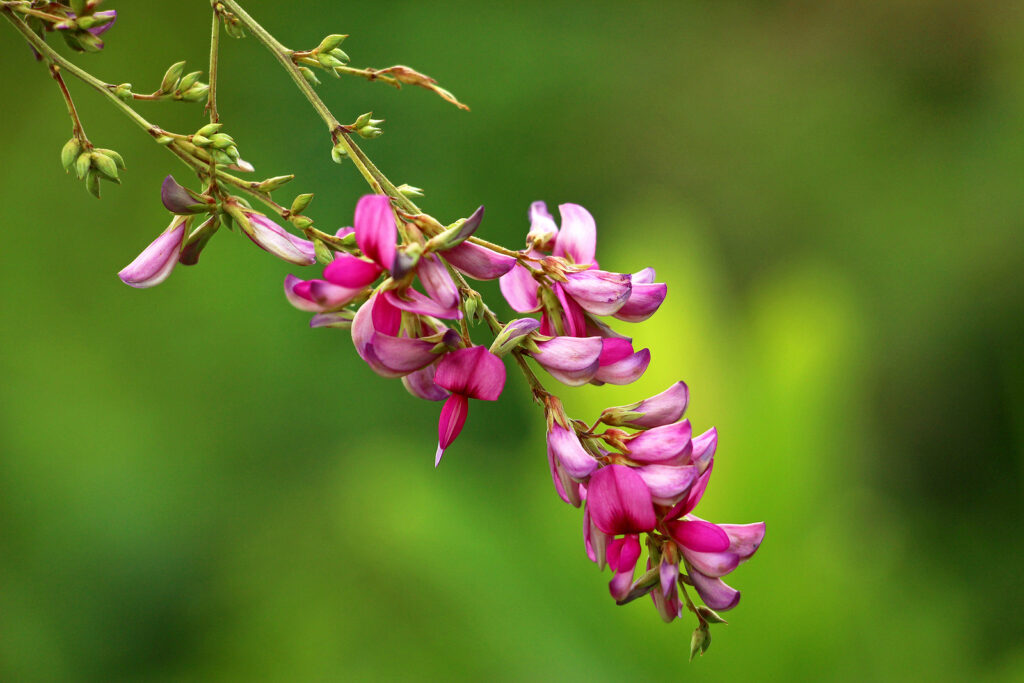Lespedeza–commonly called bush clover–is a woody-based perennial with arching branches of blue-green leaves that bear drooping 6-inch clusters of rose pink, sweet pea-shaped flowers in late summer.
Lespedeza can endure hot, dry sites and soil of low fertility. It can grow to 6 feet (1.8m) tall. Lespedeza grows rapidly; flowers appear on new growth. Lespedeza is an excellent late-flowering plant for a mixed shrub border.
Cut Lespedeza to the ground in late autumn or early spring; new growth will appear in spring.
Lespedeza is a genus of about 40 species of annuals, perennials, and small subshrubs. Lespedeza is native to meadows and grasslands in East Asia, Australia, and North America.

Get to know Lespedeza
- Plant type: Annuals, perennials, and deciduous subshrubs
- Growing zones and range: Zones 4 to 8
- Hardiness: Hardy to Zone 4
- Height and width: To 6 feet (2m) tall and 10 feet (3m) wide
- Growth rate: Slow to moderate
- Form and habit: Spreading fountain shape, clump-forming
- Foliage: Leaves are alternate and 3-palmate with three 1.5-2 inches (4-5cm) long
- Flowers: Small, pea-like flowers, profusely borne in drooping 6 inch (15cm) axillary or terminal racemes
- Bloom time: Late summer
- Uses: Mixed or shrub border, winter interest
- Garden companions: Ornamental grasses and shorter, coarser, mounded plants
- Common name: Bush clover
- Botanical name: Lespedeza
- Family name: Fabaceae
- Origin: East Asia, Australia, and North America
Where to plant Lespedeza
- Plant Lespedeza in full sun; endures hot, dry sites.
- Plant Lespedeza in light, moderately fertile, well-drained soil; prefers sandy soil of low fertility.
When to plant Lespedeza
- Set container grown Lezpedeza in the garden in spring or autumn.
- Sow Lespedeza seed in containers outdoors in spring.
Planting and spacing Lespedeza
- Plant Lespedeza 10 feet (3m) wide apart.
How to water and feed Lespedeza
- Give Lespedeza moderate to little water.
- Feed Lespedeza an acidifying fertilizer occasionally.
How to care for Lespedeza
- Where Lespedeza doesn’t die to the ground over winter, it needs a hard pruning in early spring to keep it from becoming unkempt.
- It will regrow rapidly and bear flowers on the new growth.
- Deadhead to prolong bloom; flowers grow as a multicluster.
Lespedeza pests and diseases
- Lespedeza are susceptible to attacks by leafhoppers.
- Lespedeza can also develop powdery mildew, tar spot, rust, stem rot.
Lespedeza propagation
- Take Lespedeza greenwood cuttings in early summer.
- Some species may be divided in spring, but plants rarely need it.
Lespedeza varieties to grow
- Lespedeza bicolor, upright shrub with arching shoots and 3-palmate, mid- to dark green leaves consisting of broadly oval to obovate leaflets, to 2 inches (5cm) long. In mid- and late summer, purple-pink flowers, to .5 inch (1.5cm) long, are borne in slender racemes, 2-5 inches (5-13cm) or more long, form the upper leaf axils. To 6 feet (2m) tall and wide. East Asia. Zones 4 to 8.
- L. thunbergii, wood-based perennial or subshrub with long, arching shoots and 3-palmate, blue-green leaves consisting of oval or oval-lance-shaped leaflets, to 2 inches (5cm) long. In late summer, purple-pink flowers, to .5 inch (1.5cm) long, are profusely borne in pendent, terminal racemes, to 6 inches (15cm) long. To 6 feet (2m) tall and 10 feet (3m) wide. North Chine, Japan. Zones 5 to 8.



